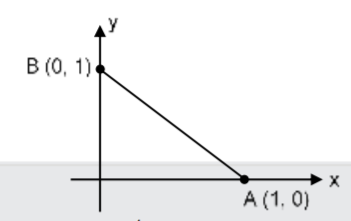A particale moves under the effect of a force F=Cx from x=0 to x=x1. The work down in the process is
Cx∘1
Cx21/2
zero
Cx31
The correct Answer is:B
To solve the problem of finding the work done by the force F=Cx as a particle moves from x=0 to x=x1, we can follow these steps:
Step 1: Understand the Work Done Formula
The work done W by a force when moving an object is given by the integral of the force over the distance moved. Mathematically, this is expressed as:
W=∫Fdx
Step 2: Substitute the Force
In this case, the force F is given as F=Cx. Therefore, we can substitute this into the work done formula:
W=∫Cxdx
Step 3: Set the Limits of Integration
The particle moves from x=0 to x=x1. Thus, we set the limits of integration accordingly:
W=∫x10Cxdx
Step 4: Perform the Integration
Now, we can perform the integration:
W=C∫x10xdx
The integral of x is:
∫xdx=x22
Thus, we have:
W=C(x22)x10
Step 5: Evaluate the Integral
Now we evaluate the integral from 0 to x1:
W=C(x212−022)=C(x212)
This simplifies to:
W=Cx212
Step 6: Conclusion
Thus, the work done by the force as the particle moves from x=0 to x=x1 is:
W=Cx212
Final Answer
The correct option is Cx212.
---
The work done W by a force when moving an object is given by the integral of the force over the distance moved. Mathematically, this is expressed as:
W=∫Fdx
In this case, the force F is given as F=Cx. Therefore, we can substitute this into the work done formula:
W=∫Cxdx
The particle moves from x=0 to x=x1. Thus, we set the limits of integration accordingly:
W=∫x10Cxdx
Now, we can perform the integration:
W=C∫x10xdx
The integral of x is:
∫xdx=x22
Thus, we have:
W=C(x22)x10
Now we evaluate the integral from 0 to x1:
W=C(x212−022)=C(x212)
This simplifies to:
W=Cx212
Thus, the work done by the force as the particle moves from x=0 to x=x1 is:
W=Cx212
The correct option is Cx212.
Topper's Solved these Questions
- WORK, ENERGY AND POWERBOOK - DC PANDEY ENGLISHCHAPTER - WORK, ENERGY AND POWEREXERCISE - CHECK POINT 6.2
20 Videos
- WORK, ENERGY AND POWERBOOK - DC PANDEY ENGLISHCHAPTER - WORK, ENERGY AND POWEREXERCISE - CHECK POINT 6.3
10 Videos
- WORK, ENERGY AND POWERBOOK - DC PANDEY ENGLISHCHAPTER - WORK, ENERGY AND POWEREXERCISE - MEDICAL ENTRACES GALLERY
33 Videos
- WORK, ENERGY & POWERBOOK - DC PANDEY ENGLISHCHAPTER - WORK, ENERGY & POWEREXERCISE - Level 2 Comprehension Based
2 Videos
- WORK, POWER AND ENERGYBOOK - DC PANDEY ENGLISHCHAPTER - WORK, POWER AND ENERGYEXERCISE - E Integer Type Questions
11 Videos
Similar Questions
Under the action of a force F = Cx, the position of a body changes from 0 to x. The work done is
View SolutionA particle moves along the X-axis from x=0 to x=5 m under the influence of a force given by F=7−2x+3x2. Find the work done in the process.
View SolutionA particle moves along the X-axis x=0 to x=5 m under the influence of a force given by F=10−2x+3x2. Work done in the process is
View SolutionA particle is moving in a force field given by potential energy U=−λ(x+y+z)from point (1,1,1) to (2, 3, 4). The work done in the process is
View SolutionA particle moves along X-axis from x=0 to x=1 m under the influence of a force given by F=3x2+2x−10. Work done in the process is
View SolutionA particle moves along X-axis from x=0 to x=1 m under the influence of a force given by F=3x2+2x−10. Work done in the process is
View SolutionA particle moves under force F=5(x−2)3 .Motion of the particle is
View SolutionParticle moves from point A to point B along the line shown in figure under the action of force. evcF=−xˆi+yˆj. Determine the work done on the particle by →F in moving the particle from point A to point B.

View SolutionA particle moves along the x-axis from x=0 to x=5m under the influence of a given by F=7−2x+3x2. The work done by the applied force to the particle is.
View SolutionA particle moves under the force F(x)=(x2−6x)N, where x is in metres. For small displacements from the origin what is the force constant in the simple harmonic motion approximation ?
View Solution
